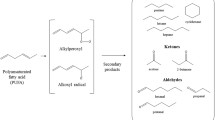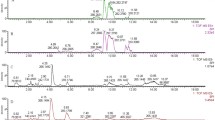Abstract
Saliva is possibly the easiest biofluid to analyse and, despite its simple composition, contains relevant metabolic information. In this work, we explored the potential of the volatile composition of saliva samples as biosignatures for breast cancer (BC) non-invasive diagnosis. To achieve this, 106 saliva samples of BC patients and controls in two distinct geographic regions in Portugal and India were extracted and analysed using optimised headspace solid-phase microextraction gas chromatography mass spectrometry (HS-SPME/GC-MS, 2 mL acidified saliva containing 10% NaCl, stirred (800 rpm) for 45 min at 38 °C and using the CAR/PDMS SPME fibre) followed by multivariate statistical analysis (MVSA). Over 120 volatiles from distinct chemical classes, with significant variations among the groups, were identified. MVSA retrieved a limited number of volatiles, viz. 3-methyl-pentanoic acid, 4-methyl-pentanoic acid, phenol and p-tert-butyl-phenol (Portuguese samples) and acetic, propanoic, benzoic acids, 1,2-decanediol, 2-decanone, and decanal (Indian samples), statistically relevant for the discrimination of BC patients in the populations analysed. This work defines an experimental layout, HS-SPME/GC-MS followed by MVSA, suitable to characterise volatile fingerprints for saliva as putative biosignatures for BC non-invasive diagnosis. Here, it was applied to BC samples from geographically distant populations and good disease separation was obtained. Further studies using larger cohorts are therefore very pertinent to challenge and strengthen this proof-of-concept study.

ᅟ




Similar content being viewed by others
Abbreviations
- BC:
-
Breast cancer
- CAR/PDMS:
-
Carboxen®/polydimethylsiloxane SPME fiber
- CTRL:
-
Control healthy subjects
- HCA:
-
Hierarchical cluster analysis
- HCl:
-
Hydrogen chloride
- HS-SPME/GC-MS:
-
Headspace solid-phase microextraction gas chromatography mass spectrometry
- IN:
-
Indian samples (Pune)
- MCCV:
-
Monte Carlo cross-validation
- MVSA:
-
Multivariate statistical analysis
- OPLS-DA:
-
Orthogonal projections to latent structures discriminant analysis
- PCA:
-
Principal component analysis
- PLS-DA:
-
Partial least squares discriminant analysis
- PT:
-
Portuguese samples (Madeira Island)
- ROC:
-
Receiver operator characteristic
- RF:
-
Random forest
- SPME:
-
Solid-phase microextraction
- VOMs:
-
Volatile organic metabolites
References
Silva CL, Passos M, Camara JS. Investigation of urinary volatile organic metabolites as potential cancer biomarkers by solid-phase microextraction in combination with gas chromatography-mass spectrometry. Br J Cancer. 2011;105(12):1894–904. https://doi.org/10.1038/bjc.2011.437.
Ullah MF, Aatif M. The footprints of cancer development: cancer biomarkers. Cancer Treat Rev. 2009;35(3):193–200. https://doi.org/10.1016/j.ctrv.2008.10.004.
Banin Hirata BK, Oda JM, Losi Guembarovski R, Ariza CB, de Oliveira CE, Watanabe MA. Molecular markers for breast cancer: prediction on tumor behavior. Dis Markers. 2014;2014:513158. https://doi.org/10.1155/2014/513158.
Yang Q, Shi X, Wang Y, Wang W, He H, Lu X, et al. Urinary metabonomic study of lung cancer by a fully automatic hyphenated hydrophilic interaction/RPLC-MS system. J Sep Sci. 2010;33(10):1495–503. https://doi.org/10.1002/jssc.200900798.
Peng G, Hakim M, Broza YY, Billan S, Abdah-Bortnyak R, Kuten A, et al. Detection of lung, breast, colorectal, and prostate cancers from exhaled breath using a single array of nanosensors. Br J Cancer. 2010;103(4):542–51. https://doi.org/10.1038/sj.bjc.6605810.
Buszewski B, Rudnicka J, Ligor T, Walczak M, Jezierski T, Amann A. Analytical and unconventional methods of cancer detection using odor. TrAC Trends Anal Chem. 2012;38:1–12. https://doi.org/10.1016/j.trac.2012.03.019.
Silva CL, Passos M, Camara JS. Solid phase microextraction, mass spectrometry and metabolomic approaches for detection of potential urinary cancer biomarkers—a powerful strategy for breast cancer diagnosis. Talanta. 2012;89:360–8. https://doi.org/10.1016/j.talanta.2011.12.041.
Pereira J, Silva CL, Perestrelo R, Goncalves J, Alves V, Camara JS. Re-exploring the high-throughput potential of microextraction techniques, SPME and MEPS, as powerful strategies for medical diagnostic purposes. Innovative approaches, recent applications and future trends. Anal Bioanal Chem. 2014;406(8):2101–22. https://doi.org/10.1007/s00216-013-7527-4.
Sun X, Shao K, Wang T. Detection of volatile organic compounds (VOCs) from exhaled breath as noninvasive methods for cancer diagnosis. Anal Bioanal Chem. 2016;408(11):2759–80. https://doi.org/10.1007/s00216-015-9200-6.
Wang C, Ke C, Wang X, Chi C, Guo L, Luo S, et al. Noninvasive detection of colorectal cancer by analysis of exhaled breath. Anal Bioanal Chem. 2014;406(19):4757–63. https://doi.org/10.1007/s00216-014-7865-x.
Subrahmanyam MV, Sangeetha M. Gingival crevicular fluid a marker of the periodontal disease activity. Indian J Clin Biochem. 2003;18(1):5–7. https://doi.org/10.1007/BF02867658.
Dodds MW, Johnson DA, Yeh CK. Health benefits of saliva: a review. J Dent. 2005;33(3):223–33. https://doi.org/10.1016/j.jdent.2004.10.009.
Milanowski M, Pomastowski P, Ligor T, Buszewski B. Saliva—volatile biomarkers and profiles. Crit Rev Anal Chem. 2017;47(3):251–66. https://doi.org/10.1080/10408347.2016.1266925.
Schipper RG, Silletti E, Vingerhoeds MH. Saliva as research material: biochemical, physicochemical and practical aspects. Arch Oral Biol. 2007;52(12):1114–35. https://doi.org/10.1016/j.archoralbio.2007.06.009.
Shah FD, Begum R, Vajaria BN, Patel KR, Patel JB, Shukla SN, et al. A review on salivary genomics and proteomics biomarkers in oral cancer. Indian J Clin Biochem. 2011;26(4):326–34. https://doi.org/10.1007/s12291-011-0149-8.
Liu J, Duan Y. Saliva: a potential media for disease diagnostics and monitoring. Oral Oncol. 2012;48(7):569–77. https://doi.org/10.1016/j.oraloncology.2012.01.021.
Reznick AZ, Hershkovich O, Nagler RM. Saliva—a pivotal player in the pathogenesis of oropharyngeal cancer. Br J Cancer. 2004;91(1):111–8. https://doi.org/10.1038/sj.bjc.6601869.
Shpitzer T, Hamzany Y, Bahar G, Feinmesser R, Savulescu D, Borovoi I, et al. Salivary analysis of oral cancer biomarkers. Br J Cancer. 2009;101(7):1194–8. https://doi.org/10.1038/sj.bjc.6605290.
Wei J, Xie G, Zhou Z, Shi P, Qiu Y, Zheng X, et al. Salivary metabolite signatures of oral cancer and leukoplakia. Int J Cancer. 2011;129(9):2207–17. https://doi.org/10.1002/ijc.25881.
Zhang L, Farrell JJ, Zhou H, Elashoff D, Akin D, Park NH, et al. Salivary transcriptomic biomarkers for detection of resectable pancreatic cancer. Gastroenterology. 2010;138(3):949–57 e1–7. https://doi.org/10.1053/j.gastro.2009.11.010.
Martin HJ, Riazanskaia S, Thomas CL. Sampling and characterisation of volatile organic compound profiles in human saliva using a polydimethylsiloxane coupon placed within the oral cavity. Analyst. 2012;137(16):3627–34. https://doi.org/10.1039/c2an35432b.
Wu JY, Yi C, Chung HR, Wang DJ, Chang WC, Lee SY, et al. Potential biomarkers in saliva for oral squamous cell carcinoma. Oral Oncol. 2010;46(4):226–31. https://doi.org/10.1016/j.oraloncology.2010.01.007.
Amann A, Costello Bde L, Miekisch W, Schubert J, Buszewski B, Pleil J, et al. The human volatilome: volatile organic compounds (VOCs) in exhaled breath, skin emanations, urine, feces and saliva. J Breath Res. 2014;8(3):034001. https://doi.org/10.1088/1752-7155/8/3/034001.
Al-Kateb H, de Lacy Costello B, Ratcliffe N. An investigation of volatile organic compounds from the saliva of healthy individuals using headspace-trap/GC-MS. J Breath Res. 2013;7(3):036004. https://doi.org/10.1088/1752-7155/7/3/036004.
Sanchez Mdel N, Garcia EH, Pavon JL, Cordero BM. Fast analytical methodology based on mass spectrometry for the determination of volatile biomarkers in saliva. Anal Chem. 2012;84(1):379–85. https://doi.org/10.1021/ac2026892.
Kusano M, Mendez E, Furton KG. Development of headspace SPME method for analysis of volatile organic compounds present in human biological specimens. Anal Bioanal Chem. 2011;400(7):1817–26. https://doi.org/10.1007/s00216-011-4950-2.
Perez Anton A, Del Nogal Sanchez M, Crisolino Pozas AP, Perez Pavon JL, Cordero BM. Headspace-programmed temperature vaporizer-mass spectrometry and pattern recognition techniques for the analysis of volatiles in saliva samples. Talanta. 2016;160:21–7. https://doi.org/10.1016/j.talanta.2016.06.061.
Xia J, Sinelnikov IV, Han B, Wishart DS. MetaboAnalyst 3.0—making metabolomics more meaningful. Nucleic Acids Res. 2015;43(W1):W251–7. https://doi.org/10.1093/nar/gkv380.
Aguirre-Gonzalez M, Taborda-Ocampo G, Dussan-Lubert C, Nerin C, Rosero-Moreano M. Optimization of the HS-SPME technique by using response surface methodology for evaluating chlorine disinfection by-products by GC in drinking water. J Braz Chem Soc. 2011;22(12):2330–6.
Camara JS, Alves MA, Marques JC. Development of headspace solid-phase microextraction-gas chromatography-mass spectrometry methodology for analysis of terpenoids in Madeira wines. Anal Chim Acta. 2006;555(2):191–200. https://doi.org/10.1016/j.aca.2005.09.001.
Gorecki T, Pawliszyn J. Effect of sample volume on quantitative analysis by solid-phase microextraction. Part 1. Theoretical considerations. Analyst. 1997;122(10):1079–86. https://doi.org/10.1039/A701303E.
Gorecki T, Khaled A, Pawliszyn J. The effect of sample volume on quantitative analysis by solid phase microextraction—part 2. Experimental verification. Analyst. 1998;123(12):2819–24. https://doi.org/10.1039/a806788k.
Ulrich S. Solid-phase microextraction in biomedical analysis. J Chromatogr A. 2000;902(1):167–94. https://doi.org/10.1016/S0021-9673(00)00934-1.
Ulanowska A, Ligor T, Michel M, Buszewski B. Hyphenated and unconventional methods for searching volatile cancer biomarkers. Ecol Chem Eng S. 2010;17(1):9–23.
Cummings JH. Short chain fatty acids in the human colon. Gut. 1981;22(9):763–79.
Haick H, Broza YY, Mochalski P, Ruzsanyi V, Amann A. Assessment, origin, and implementation of breath volatile cancer markers. Chem Soc Rev. 2014;43(5):1423–49. https://doi.org/10.1039/c3cs60329f.
Miekisch W, Schubert JK, Noeldge-Schomburg GF. Diagnostic potential of breath analysis—focus on volatile organic compounds. Clin Chim Acta. 2004;347(1–2):25–39. https://doi.org/10.1016/j.cccn.2004.04.023.
de Lacy Costello B, Amann A, Al-Kateb H, Flynn C, Filipiak W, Khalid T, et al. A review of the volatiles from the healthy human body. J Breath Res. 2014;8(1):014001. https://doi.org/10.1088/1752-7155/8/1/014001.
Mandel J, Schmitt P (2015) A comparison of six methods for missing data imputation. J Biom Biostat ;06(01). doi:https://doi.org/10.4172/2155-6180.1000224.
Broadhurst DI, Kell DB. Statistical strategies for avoiding false discoveries in metabolomics and related experiments. Metabolomics. 2006;2(4):171–96. https://doi.org/10.1007/s11306-006-0037-z.
Westerhuis JA, Hoefsloot HCJ, Smit S, Vis DJ, Smilde AK, van Velzen EJJ, et al. Assessment of PLSDA cross validation. Metabolomics. 2008;4(1):81–9. https://doi.org/10.1007/s11306-007-0099-6.
Acknowledgments
This research was supported by Fundação para a Ciência e a Tecnologia (projects PEst-OE/QUI/UI0674/2013, CQM, New-INDIGO/0003/2012 and INNOINDIGO/0001/2015, Portuguese Government funds), and through Madeira 14-20 Program, project PROEQUIPRAM - Reforço do Investimento em Equipamentos e Infraestruturas Científicas na RAM (M1420-01-0145-FEDER-000008) and by ARDITI - Agência Regional para o Desenvolvimento da Investigação Tecnologia e Inovação, through the project M1420-01-0145-FEDER-000005 - Centro de Química da Madeira - CQM+ (Madeira 14-20), and project M1420 - 09-5369-FSE-000001 for the Post-Doctoral fellowship granted to JAMP. SR, KT, and HN gratefully acknowledge the support of Department of Biotechnology (DBT), Government of India (New Indigo project grant no. BT/IN/New Indigo/03/RS/2013) and Department of Science & Technology (DST), Government of India (Inno-Indigo NCD-CAPomics project grant no. DST/IMRCD/EU/Inno-Indigo/NCDs-CAPomics/2015). RT acknowledges Council of Scientific and Industrial Research (CSIR), New Delhi, India, for research associateship. SR, KT and RT would like to acknowledge Col. Dharmesh Soneji (AFMC, Pune) for sample collection.
Author information
Authors and Affiliations
Corresponding author
Ethics declarations
This work involved human participants and previous clearance from the ethical committees of the institutions involved, as well as signed informed consent of the subjects recruited, was obtained.
Conflict of interest
The authors declare that they have no conflict of interest.
Electronic supplementary material
ESM 1
(PDF 2.15 mb)
Rights and permissions
About this article
Cite this article
Cavaco, C., Pereira, J.A.M., Taunk, K. et al. Screening of salivary volatiles for putative breast cancer discrimination: an exploratory study involving geographically distant populations. Anal Bioanal Chem 410, 4459–4468 (2018). https://doi.org/10.1007/s00216-018-1103-x
Received:
Revised:
Accepted:
Published:
Issue Date:
DOI: https://doi.org/10.1007/s00216-018-1103-x




